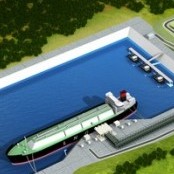As competing groups pressure the Obama administration to both speed up and slow down approvals to sell US natural gas overseas, the Energy Department just authorized exports from a proposed Oregon terminal. Although the Jordan Cove LNG Terminal in Coos Bay, Oregon is the sixth project to win a license to export LNG to countries that don't have free-trade agreements with the United States, it was the first new export project on the West Coast.

Unlike other companies that are turning around existing LNG import facilities, Jordan Cove will be a new, greenfield project, designed to take advantage of gas from the Rockies. As a mater of fact, in February, Canadian officials gave Jordan Cove's parent company, Veresen, permission to process Canadian natural gas.
That appears to give Jordan Cove a major advantage supplying Asian countries petitioning Washington weekly to help bring down the natural gas price spike created after Japan shut down its nuclear reactors. If you consider that European prices typically trade at around $8-10/MMBtu compared to $14-18/MMBtu in Asia, it seems like a no brainer to follow that spread.
High prices are important to Veresen, which says the new project will cost a hefty $7.5 billion, according to The Oregonian. The huge buildout includes the four train liquefaction terminal, a 230-mile feeder pipeline, and a natural gas-fired power plant to keep the operation running, as it exports up to 800 million standard (Bcf/d) a year.
An alarm bell for manufacturers
Adding up the output of all six approved projects means that 9.3 billion cubic feet of natural gas could be sent each day to non-free-trade partners. It would put the US nearly neck and neck with Qatar - the world's largest exporter - which has 10.3 billion cubic feet of daily natural gas export capacity.
That's a threshold near the upper bounds of export levels analyzed in a 2012 study conducted for the DOE, placing it in a "high-export scenario." Since two dozen more applications are pending, manufacturers and other big natural gas users are pushing back and pressing the Energy Department to halt reviews and conduct a fresh examination of how high levels of exports could affect domestic prices for the fossil fuel.
The race to Asia is on
Jordan Cove's head start lasted only one day before the Canadian government followed up and approved four, long-term licenses to export LNG from proposed projects on the its west coast. Suddenly the walk in the park to Asia looks like a horse race.
The licenses are for LNG exports from terminals backed by Exxon Mobil, BG Group ,and Malaysian state-owned Petronas, although none of these projects have been built or even formally approved by their sponsors.
As the field becomes more crowded, some analysts have voiced caution, Bloomberg wrote. They feel that the liquefaction buildout may start lowering Asian prices after 2016 as the US, Canada, and Australia all come on line, Qatar pivots to Asia, and Japan boosts the amount of power it gets from nuclear energy.
Hopefully, winners and losers should sort themselves out when they try to attract capital and line up enough customers willing to ink 20-year-contracts for liquefied natural gas carried on tankers around the globe.
That's basically what John Watson, chief executive officer of Chevron, told reporters. He knows from experience that many of the proposals will fall away without guaranteed buyers; so supply won't exceed demand, he said, adding, "Even companies the size of Chevron don't build LNG plants without having contracts in hand."
As an example, Jordan Cove received an import license in 2009, just as US natural gas prices were collapsing. Obviously, the project was no longer economically viable. It was shelved. Later, when production surged, backers dusted the plans off, changed the direction, and resubmitted their application to become an export terminal serving that alluringly lucrative Asian market.


